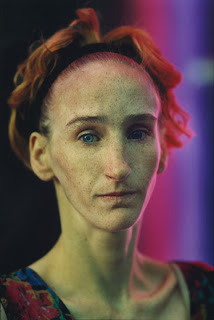Robert Bergman: photography: a kind of rapture
interest and relations:
An element of Bergman's work is the lack of identity and information to the individual, but something that substitute that element is another element; the subject is identified with original, individuality in expression. Bergman is able to place himself to the same level as his subject. He is able to make his subject comfortable and at ease to be able to capture them with these introspective feelings on their faces. Their expressions are rich in the eyes, the pose, the facial features are emotional landscape to read, decipher and relate. The lack of identity and information makes the expression relatable to anyone, the feelings do not belong to just an individual, but expansive to those who wishes to engage. I like a point that Bergman made, that we must not assume that we know these individual due to their look. We tend to jump to conclusion that by being presented these individuals portraits, we know who they are. We must look past that. Bergman pointed out that, "They're the life-size faces of people most of us usually overlook, or think we have all figured out." I think sometimes, as a viewer we tend to do that, think that we have it all figured out. A portrait of someone does not mean that the artist has completely handed over the person to the viewer. The artist merely has only opened the door to the individual for the viewer.
biography:
It's part of the Bergman creed: no titles for the photographs, no identification of the subject, no information on the location. Just the year, just the close-up.
"And at first glance, Bergman's photographs may not seem that different: an emaciated man looks pensively to the side; an old woman with frizzy gray hair stares directly at the lens, directly at us. These photos all have something in common, and it seems to be the usual commentary on class.
But among these subjects, according to Bergman, "there's a housewife, there are three artists, there are two actors, an affluent owner of a bar; there's the son of a millionaire and the granddaughter of a billionaire."
Still, you can't tell who's who — and Bergman won't say. He makes a point of including very little information in his photographs: no captions, no titles, no names. He doesn't even include the scene. The photos are tightly centered around the face, and that's what makes them slightly uncomfortable: They're the life-size faces of people most of us usually overlook, or think we have all figured out."quotes:
"It is my aesthetic stance. I don't want you to have any escape from simply reacting to the art," Bergman says, dancing slightly in his black nubuck shoes. "Telling the location sets up false assumptions. It undercuts your ability to understand and interact with the art. It subverts what I am trying to do." - Bergman
"When I first saw his photos, I was actually kind of amazed by the strength of the images and the extraordinary use of color. It's beautiful and saturated," Greenough says. "In addition, I admired his ability to put his subjects totally at ease and to capture them with these introspective feelings on their faces."
images:





review, artist & gallery link:
http://brooklynrail.org/2004/05/art/bergman
http://www.npr.org/templates/story/story.php?storyId=120283879
http://www.washingtonpost.com/wp-dyn/content/article/2009/10/12/AR2009101202981.html

0 comments:
Post a Comment